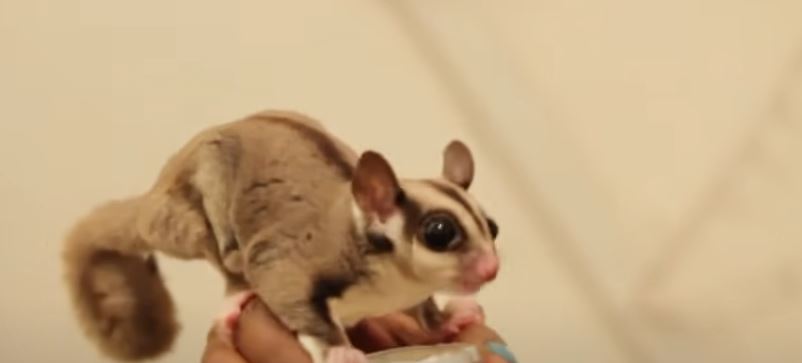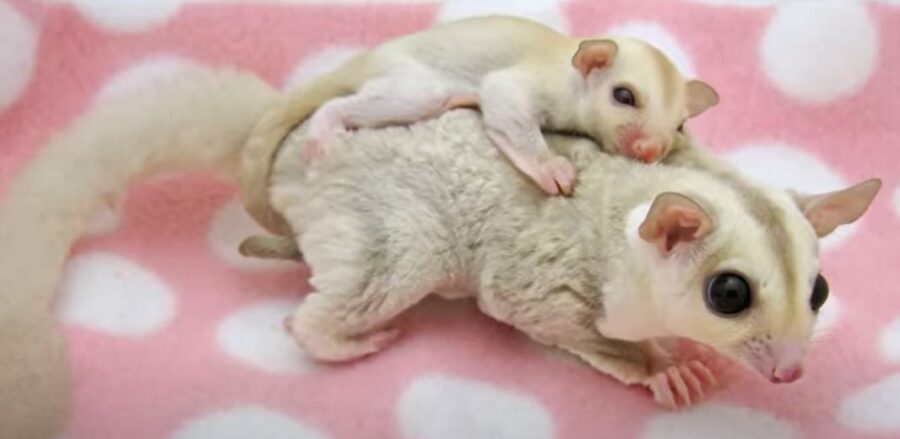This is a good time for my friends with sugar gliders to find out what does it mean when a sugar glider curls its tail?
His or her tail curls up for many reasons or sometimes for no reason at all. Allow me to explain.
What Does It Mean When a Sugar Glider Curls Its Tail?
Sugar gliders are able to explore their world by the use of their tail. They can grip with their tail and use it to play with toys. Sometimes sugar gliders curl their tails when they are nervous. Curling their tail is a form of self-defense.
If your sugar glider is startled by someone entering the room or a loud noise they may also curl up their whole body including their tail. Other time sugar gliders curl their tails when they wake up.
What To Do About It
If you are noticing that your sugar glider is not warming up to their surroundings or you, the curled tail can be a sign that things are not yet going smoothly enough during the adjustment phase.
Make some changes to the environment, keep the cage comfortable clean and spacious, add levels and chew toys. Always be patient and loving with your gentle actions and soothing voice.

How Do I Know if My Sugar Gliders Nervous?
Telltale signs of a sugar glider feeling nervous is when they curl up their tail. They do it when they are startled. Sugar gliders who have not yet bonded or trust their human caregivers, may show these signs:
- excessive hiding
- lack of appetite
- lethargy
- shaking
- biting
- curled tail
- hyper
Use your gentle voice with slow limited actions. Lower the lighting and volume. Hand feed to gain your sugar glider’s trust over the coming days and weeks.
Excessive licking might need to be added to this list. Better yet, it needs its own article.
Do Sugar Gliders Play With Their Tails Curled?
Yes. Our sugar glider is interacting with her cage and the levels that we have built inside including all the toys. When she is ready to play, she curls up her tail and runs or jumps.
We have even seen her picking leaves and curling them in her tail. It’s interesting to watch the quirky behaviors of sugar gliders in the way that they use their tails.
Overall, we feel that our sugar glider is healthy when she is curling her tail and using it as a form of mental and physical stimulation. She’s interacting with her world this way.

When Do Sugar Gliders Curl Their Tails?
Have you ever seen a mama sugar glider with two of her joeys hanging off of her tail? Sugar gliders can hang out or grab items and keep them curled in their tail.
It’s a way for them to hold onto things when they interact with their world. Sometimes they curl their tails out of fear, nervousness or because they are startled.
Other reasons are because they have just woken up and are stretching their body and curling a tale as a result. The movement of a sugar glider’s tail is similar to the way we make facial expressions or move our upper bodies.
If you also hear sugar gliders barking, there is more to be concerned about. I’ll explain that right here.

Why Isn’t My Sugar Glider Curling up Her Tail?
Some sugar gliders don’t interact with their world the way others do. They don’t use their tail the way they do in the wild. Your sugar glider could be an inactive or simply disinterested in exploration.
A sugar glider that has everything that they need, may not feel uncomfortable or fearful to resort to curling up their tail.
You may not notice them feeling cold or curling up to stay warm to go to sleep. Don’t be concerned if your sugar glider is not curling their tail.
Conclusion
Tail movements are very normal because it acts like another limb on your sugar glider. They can curl up their tails during all kinds of activities such as eating, playing, caring for their young, stretching or sleeping.
If your sugar glider is excessively hiding, giving up eating and not interacting with you with a curled-up tail you may need to adjust the environment or find out if there are any other types of issues. A visit to the vet might be in order if this behavior doesn’t change.
Thank you for visiting PocketPetCentral.com for the best information to help you enjoy the life of your pocket pet companion in a fun, safe & healthy way.


